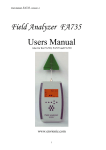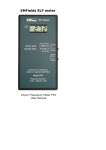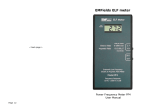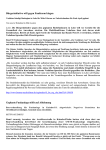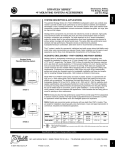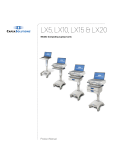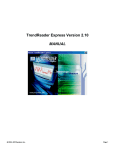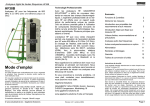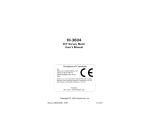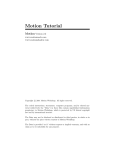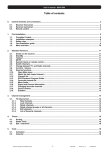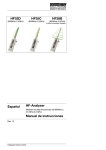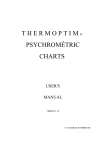Download Field Analyzer FA300
Transcript
User manual FA735 version 1.0
Field Analyzer FA735
Users Manual
Also for the FA720, FA725 and FA730
www.envionic.com
1
User manual FA735 version 1.0
Contents
Introduction.................................................................................................................................. 3
Accessories .............................................................................................................................. 5
Chapter 1 General ....................................................................................................................... 6
1.1
Switching ON or OFF .................................................................................................. 6
1.2
Micro-SD memory card ............................................................................................... 7
1.3
Choosing what to measure ........................................................................................... 8
1.4
Speaker ........................................................................................................................ 9
1.5
Batteries ..................................................................................................................... 10
1.6
Changing or charging batteries .................................................................................. 11
1.7
Setting time and date ................................................................................................. 12
Chapter 2 High frequency electromagnetic field ...................................................................... 13
2.1
Measurement with LogPer antenna ........................................................................... 13
2.2
Measurement with non-directional antenna............................................................... 14
2.3
Display ....................................................................................................................... 14
2.4
Frequency measurement ............................................................................................ 15
2.5
Hold function ............................................................................................................. 16
2.6
Choosing the measurement unit................................................................................. 16
2.7
Display signal pulsation ............................................................................................. 17
2.8
Safe values ................................................................................................................. 18
Chapter 3 Low frequency electric field .................................................................................... 19
3.1
Orientation ................................................................................................................. 19
3.2
Measurements ............................................................................................................ 20
3.3
Safe values ................................................................................................................. 21
Chapter 4 Low frequency magnetic field ................................................................................. 22
4.1
Measurement.............................................................................................................. 22
4.2
Safe values ................................................................................................................. 23
Chapter 5 Displaying logged measurement results .................................................................. 24
5.1
Display measurements on the FA735 ........................................................................ 24
5.2
Connecting the Micro-SD card to your PC................................................................ 26
5.3
View measurements with your computer .................................................................. 27
Appendices ................................................................................................................................ 28
Appendix 1 Specifications FA735..................................................................................... 28
Appendix 2 Conversion from microwatt /m² to milliVolt /meter. .................................... 29
Appendix 3 More information ........................................................................................... 30
Appendix 4 Abbreviations ................................................................................................. 30
2
User manual FA735 version 1.0
Introduction
This manual is intended for the FA735, and also for the FA720, FA725 and FA730. But these
last three devices do not have all features of the FA735.
The features of the four devices can be found in the next table:
FA720 FA725 FA730 FA735
●
●
●
●
●
●
●
●
●
●
●
●
RF High frequency measurement up to 6 GHz
Low frequency electric field measurement
Low frequency magnetic field measurement
Data logging on micro-SD memorycard
Software upgrade through micro-SD card
For the RF field, not only the strength, but also its frequency can be measured.
The strength of the field is also shown in a graph, as a function of the frequency.
The figures measured are displayed on a clear graphic LCD display.
When measuring high frequency radiation, the pulsation can be heard via the build in speaker.
In the ‘time’ mode, you can view these pulses on the screen.
The low frequency fields are also audible on the speaker, and their waveform is visible on the
screen.
The data logging function writes the measurement result to a micro-SD memory card every 10
seconds. It writes the current time and date together with these measurements. The recorded
data can be viewed on the device itself, or on your PC (as an Excel spreadsheet).
The internal software can be upgraded through the micro-SD card.
3
User manual FA735 version 1.0
The FA735 is a sensitive measurement device that measures three kinds of fields.
The fields measured are:
1) High frequency electromagnetic fields that are emitted by:
- GSM mobile telephones and their base station/ broadcasting masts
- UMTS mobile telephones and their base station/ broadcasting masts
- DECT cordless phone base stations (they emit regardless in use or not)
- DECT cordless telephones
- WLAN (or WIFI) wireless computer networks
- WIMAX wireless network
- wireless video systems
- microwave ovens
- bluetooth wireless systems
- television transmitters
2) Low frequency electric fields (FA 730/735 only) that are emitted by:
- Home supply power lines
- 110 or 230 volt wall sockets and connected appliances (also when switched off)
- Out door electric power lines
3) Low frequency magnetic fields (FA 730/735 only) that are emitted by:
- Power adapters
- Many 110 / 230 volt appliances
- Alarm clocks
- Transformers of halogen incandescent lamps
- outdoor electric power lines
- electric motors/ engines
4
User manual FA735 version 1.0
Accessories
The FA735 is delivered together with:
1.
2.
3.
4.
5.
6.
a LogPer directional antenna for the range 1,8 tot 6,0 GHz
a non-directional antenna for the range 800 – 1000 MHz
a micro-SD memory card of 1 Gigabyte or more
a cardreader to connect the micro-SD card to the USB port of your computer
two AA Alkaline batteries (or, optional, two NiMH rechargeable batteries)
charger for the NiMH rechargeable batteries (option)
Items 3 and 4 are delivered only with the FA735 and FA725.
The accessories can be from another brand than shown here..
5
User manual FA735 version 1.0
Chapter 1 General
1.1
Switching ON or OFF
The device is switched on by shortly pressing the little button that is located at the top side.
Pressing the same button again switches the device off.
On/Off switch
The function of the frontside buttons will be visible on the bottom of the screen as long as the
device is switched on.
On the screen you will see the model number (FA735, FA730, FA725 or FA720), software
version (V 1.4) and serial number (0216) of the device.
Screen after power-on ( Home )
The operating state of the meter is always visible at the left top of the screen. Immediately after
switching on, this is 'Home'.
You will also see the current date and time (for FA735 and FA725). When the date or time is
not correct, you can set these (see section 1.7).
6
User manual FA735 version 1.0
1.2
Micro-SD memory card
The micro-SD memory card should only be placed or removed when the device is switched
off. The card should be placed with its contacts pointing upwards to the top of the device .
You can use your nail to push it the last stretch until it clicks.
Position of the micro-SD memory card
Contacts of the card pointing upwards
7
User manual FA735 version 1.0
1.3
Choosing what to measure
The function of the frontside buttons will be visible on the bottom of the screen as long as the
device is switched on. Directly after switching on, you can choose between:
Push the 1st button (“RF”) to measure the high frequency electromagnetic field (chapter 2).
Push the 2nd button (“Elec”) to measure the low frequency electric field (chapter 3).
Push the 3rd button (“Magn”) to measure the low frequency magnetic field (chapter 4).
After measuring, you can go back to this screen with the 1st button (“Home”).
8
User manual FA735 version 1.0
1.4
Speaker
After choosing what to measure, you can set the sound to a certain volume with the buttons
"Vol+" and "Vol-".
During setting of the volume, the volume setting is displayed. It can be set to a value on a scale
from 0 to 8.
For RF, this gives an audible impression of the pulse modulation of the radiation. After some
practice it is possible to identify the kind of radiation by the sound it produces. The strength of
the radiation has not much influence on the sound volume. Weak signals can produce almost as
much sound as strong signals.
For the low frequency measurements, the sound volume depends on the strength of the signal.
To make low frequencies (50 or 60 Hz) audible, some higher harmonics are added to the
speaker signal.
Phones connection
One of the two channels of the stereo phones connection provides the sound signal to an
external device. The internal speaker will be switched off when this connection is used.
9
User manual FA735 version 1.0
1.5
Batteries
Battery condition
When the batteries are almost empty, this will be shown on the screen:
- At first, as a partly filled battery (see picture)
- After some time, the filling in the battery picture will blink
- When the battery can no longer be used, an empty battery symbol will blink. After that,
the device will switch itself off.
Two AA batteries can be found at the backside of the device
Battery compartment
Batteries
10
User manual FA735 version 1.0
1.6
Changing or charging batteries
Mains adapter connection
If rechargeable batteries are used, you can charge them by connecting the delivered wall
adapter to the device and to an outlet. After 10 hours, the batteries will be charged completely.
The device should be switched off while the batteries are charged.
Caution:
- pay attention to the polarity ( + / - ) when you place the batteries
- only use 5 volts adapters (center terminal positive)
- do not charge non-rechargeable batteries
- used batteries should be handled as chemical waste
If you want to check if the batteries are being charged, then switch the device on. You will see
an animated picture of a battery that that is being filled. Then you can switch the device off
again. If you keep the meter on while the batteries are being charged, this will extend the
charging time, because a part of the charging current will be used to power the device.
When you change the batteries, then try to do that within one minute. After one minute, the
internal clock may loose the current time and date, and you will have to set these again.
Please be aware that most newly bought NiMH rechargeable batteries have to be charged
before the first use.
If you use ordinary (non-rechargeable) batteries, then Alkaline typed are preferred.
The optional power adapter is suitable for mains voltages from at least 100 Volts up to 240
Volts AC.
11
User manual FA735 version 1.0
1.7
Setting time and date
At the home screen, press the ‘Menu’ (button 4) and then the ‘Time’ (button 4 and/or 5). Then
activate ‘Time’ with button 6.
Press the ‘OK’ button after setting time and date.
Duing measurements, the time will be shown at the left side of the screen.
Time at the left side of the screen
12
User manual FA735 version 1.0
Chapter 2 High frequency electromagnetic field
When this is selected, "RF" (Radio Frequency) will be visible at the upper left top of the
screen.
A suitable antenna must be connected. Two antennas are delivered together with the device:
A LogPer directional antenna for the range 1,8 - 6,0 GHz
A non-directional antenna for the range 800 – 1000 MHz
The measured value strongly depends on the position of the device i.e. its distance and angle to
the source of radiation, especially for indoor measurements. Radiation is generally not emitted
with the same strength in all directions.
In most indoor situation, the radiation is coming directly from the source but can also be
reflected by big objects (indoor or outdoor objects). The combination of direct and reflected
signals causes interference patterns. Due to interference the measured value can vary a lot,
even when the device is moved only about 10 or 20 cm. The interference pattern can also be
heard via the speaker.
The highest value measured is used to determine if the amount of radiation is acceptable. The
hold mode makes it easy to determine the highest value measured when moving the device
through the room.
2.1
Measurement with LogPer antenna
Measurement position with LogPer antenna
This antenna is for the range 1,8 - 6,0 GHz.
The LogPer antenna should be pointed in the direction in which you want to measure.
In most cases, the green 'triangle' of the antenna should be vertical, because most signals have
vertical polarization. The device itself will mostly be horizontal in these cases.
13
User manual FA735 version 1.0
2.2
Measurement with non-directional antenna
800-1000 MHz antenne
For the non-directional antenna, the device should be held in a vertical position, with the
antenna pointing upwards. This will receive signals from all around you. Signals that come
from the direction behind your back will be displayed less strong, because these are attenuated
while travelling through your body.
Most signals have a “vertical polarization”. Due to this, a vertical position of the device is
optimal when using the non-directional antenna. Signals with “horizontal polarization” can be
measured by holding the device in a horizontal position.
The polarization of radiation might change when it is reflected from a metal object. Also, the
polarization of a signal can be somewhere between horizontal and vertical.
2.3
Display
On the screen you can now directly read the strength of the signal ( in microwatt per square
meter). When the signal is pulsed, the shown strength is the strength at the top of the pulse.
The frequency of all signals is measured (if possible) and the frequency of the strongest signal
is shown at the left side of the screen (here: 0.9GHz). See section 2.4.
14
User manual FA735 version 1.0
2.4
Frequency measurement
The frequency of all signals is measured, and the frequency is assigned to one of the following
categories:
from 0,3 up to 2,8 GHz, 26 categories, ascending per 0,1 GHz
from 3,0 up to 4,0 GHz, in category “3 - 4”
from 4,0 up to 5,0 GHz, in category “4 - 5”
from 5,0 up to 6,0 GHz, in category “5 - 6”
or the category “Any” if the frequency can not be measured.
On the screen you will see a bar chart, that shows the signal strength per category.
The bar display is logarithmic, this means that you can also see small signals while strong
pulses of another frequency are present.
Above the signal with the highest strength you will see a small arrow, and the corresponding
frequency category is visible at the left side of the screen, with a 'GHz' indication beneath it.
The frequency measurement does not work under all circumstances. The following conditions
apply:
The signal has to be strong enough
The signal must not be stronger than the FA735 can measure
The signal must be sufficiently stronger than signals with another frequency that are present at
the same moment.
When one of these conditions is not met, then the signal will most likely change from category
when you move the device around.
Frequency of several radiation sources
15
User manual FA735 version 1.0
2.5
Hold function
The device will remember the highest measured value for every frequency category. This is
visible as a small dash above the bar of the category.
When HOLD is switched on, this highest measured value will be displayed instead of the
current value.
This is switched on as follows:
Use button 4 or 5 to switch to the 'Hold' function group. Now you can switch the "Hold"
function on or off with button 3. When hold is switched on, you will see "Hold" at the left side
of the screen. With button 6 ("Clr") you can reset the hold-values to the current actual value.
2.6
Choosing the measurement unit
Within the "Hold" function group you will als find the "Unit" button (button 2). Here you can
change the measurement unit of the device, you can choose between:
- microwatt per square meter
- millivolt per meter
- dBm (measures the energy level at the antenna connector)
16
User manual FA735 version 1.0
2.7
Display signal pulsation
Instead of a bar diagram that shows the signal strength as a function of the frequency category,
you can also show the signal strength as a function of time. If the signal is pulsed, this will
show the pulses of the signal.
Use button 4 or 5 to select functiongroup “Disp”. With button 2, you can now set the
“Time”display. At the left of the screen, you will now see “Time”instead of “GHz”.
Pressing button 2 again (it is now called “Freq”) will switch back to the normal display.
The following example shows the pulses of a DECT base station. (The dotted line is the
“Hold”value”). At the left of the screen you will also see the frequency (1.8 GHz). This is not
the impulse frequency !
Pulsed DECT signal
A non-pulsed (continuous) signal will be displayed as follows: (example: CT1 cordless
telephone ):
Non-pulsed signal
Within this functiongroup “Disp”, you can use button 3 (“Lt-“) en 6 (“Lt+”) to change the
backlight.
When there is direct sunlight, you get a good visibility by switching the backlight off.
17
User manual FA735 version 1.0
2.8
Safe values
When you choose "Safe", you will see (together with the measured value) what values are safe
for the RF electromagnetic field strength during sleep, according to the german SBM2008
standard. Also the values with qualification “slight concern”, “severe concern” and “extreme
concern” will be visible.
This only works in the microwatt per square meter setting.
Again pressing “Safe” will switch back to the normal display.
For indoor living or working areas, you can use values that are 10 times higher than the values
during sleep, that are shown here.
18
User manual FA735 version 1.0
Chapter 3 Low frequency electric field
3.1
Orientation
Electric field sensor position
The sensor is at the back side of the device. The device should be held in a vertical position,
with the sensor pointing to the direction in which you want to measure.
Do not put your hand in front of the sensor, this will attenuate the electric field and result in a
measurement result that is much too low.
The device should be ‘grounded’ by placing one of your fingers at the grounding point at the
backside of the device.
Grounding point
The device responds to changes in the surrounding electric field. This means that it will respond to the
50 Hz changing field of the electric wiring and devices in the house, but it will also respond to a change
in the static electric field.
A static electric field can be as strong as 1000V/m and it will not be the same at every place in the
room. A small movement in this field can produce a high result on the screen. Thus the device should
not be moved during the measuring procedure.
The static electric field can change as well when someone else walks through the room and this also
can have an influence on the measurement result.
19
User manual FA735 version 1.0
3.2
Measurements
The display will show the strength of the electric field in V/m (Volts per meter). It will also
show the waveform. The vertical height of the waveform is automatically adjusted for optimal
visibility.
The range is 0,5 V/m up to 199 V/m.
After switching the device on, it will take 20 seconds before the electric field can be measured.
If you choose “Hold” (switch this on as described in chapter 1), the measurements will stop,
and the last measurement will be frozen on the screen, until “Hold”is switched off again.
The distance to the source of the field has a big influence on the measurement result.
20
User manual FA735 version 1.0
3.3
Safe values
When you choose "Safe", you will see (together with the measured value) what values are safe
for the electric field strength during sleep, according to the german SBM2008 standard. Also
the values with qualification
“slight concern”, “severe concern” and “extreme concern” will be visible.
Again pressing “Safe” will switch back to the normal display.
For indoor living or working areas, you can use values that are 10 times higher than the values
during sleep, that are shown here.
21
User manual FA735 version 1.0
Chapter 4 Low frequency magnetic field
4.1
Measurement
The magnetic field sensor is placed at the right side of the device. The human body does not
shield the magnetic field (as opposed to the electric field), so it is not very important how the
device is held in your hand.
The device should be hold in several position, because it is only sensitive to a single direction
of the magnetic field lines. The highest measured value should be used.
The device should not be moved during the measurement.
Magnetic sensor position
The display will show the strength of the magneticic field in microTesla. It will also show the
waveform. The vertical height of the waveform is automatically adjusted for optimal visibility.
The measurement range is from 0,01 µT up to 3,99 µT.
The distance to the source of the magnetic field has a big influence on the measured strength of
the magnetic field.
22
User manual FA735 version 1.0
After switching the device on, it will take 20 seconds before the electric field can be measured.
If you choose “Hold” (switch this on as described in chapter 1), the measurements will stop,
and the last measurement will be frozen on the screen, until “Hold”is switched off again.
4.2
Safe values
When you choose "Safe", you will see (together with the measured value) what values are safe
for the magnetic field strength during sleep, according to the german SBM2008 standard. Also
the values with qualification “slight concern”, “severe concern” and “extreme concern” will be
visible.
Again pressing “Safe” will switch back to the normal display.
For indoor living or working areas, you can use values that are 10 times higher than the values
during sleep, that are shown here.
23
User manual FA735 version 1.0
Chapter 5 Displaying logged measurement results
5.1
Display measurements on the FA735
Every 10 seconds, the FA725 and FA735 devices store the measured value on their micro-SD
memory card.
You can examine all measurements. Press button 4 or 5 to choose the “Mem” functiongroup.
Then push button 3, “Hist””. An overview appears with measurements of the current day.
Measurements of one day
In the top line yo see the year, month, date and the day of the week.
Choose the kind of measurements that you want to see (with button 6), for instance
“RF uW/m²”.
Use the upper option “..” to get an overview of all measurements of the current month. Again
choosing “..” gives an overview measurements of all months.
You can also get an overview of measurements of all months from the “Home” start screen.
Just select “Menu” and then “Card”and “Log”.
If the memory card is not present, you will get a warning directly after switching the device on.
24
User manual FA735 version 1.0
Signal strength per quarter of an hour
After selecting the measurement, you will see a bar diagram with the maximum strength of
every time period. Every bar in the diagram is a period of 15 minutes.
With the arrow buttons (3 and 6) you can move the little arrow on the screen to the left and to
the right, selecting a certain time period. The maximal signal strength of the selected period
will be shown at the top of the screen. In the next example (signal strength per 10 sec) this
little arrow is under the “1” of the value “160”.
The starting time of the choosen time period is shown at the top left corner of the screen (in the
example: october 22, 12:00). The frequency category that belongs to the choosen time period,
is at the left side of the screen.
There are 32 time periods on screen, together this is 8 hours. The other hours of the day
become visible by moving the arrow to the side of the screen.
The arrow buttons have an auto-repeat function. The button function will repeat if the button is
pressed for longer than half a second.
Signal strength per 10 sec (zoom)
If you want a more detailed overview, you can press button 2 (“Zoom”). This will enlarge the
choosen 15 minutes to 90 bars of 10 seconds each. The Zoom state will be indicated at the left
side of the screen.
Pressing “Zoom”again will bring you back to the bars of 15 minutes.
25
User manual FA735 version 1.0
5.2
Connecting the Micro-SD card to your PC
You can also see the stored measurements as a spreadsheet on your PC with Microsoft Excel.
Switch the device off, and remove the micro-Sd card. Use your nail to press the micro-SD
card a little, the card will then be released and you can take it out.
Put the micro SD card in the cardreader
Push the slide of the cardreader
Use the cardreader (that is included with the FA725/735) to connect the micro-SD card to a
USB port of your computer. The cardreader should be placed with the blue side facing
upwards. (It will fit in two ways, but it will work in only one way).
As soon as the cardreader is attached to the PC, a window will pop up.
Choose “Open folder to view files”. Then choose the folder “Log”, and then select the month
and day of the measurements that you want to see.
In this folder you see a file xx-yyyzz.csv,
( xx = A..Z, yyy = month, zz=day), for example AJ-OCT22.CSV
When you click on this file, Microsoft Excel will open and show the measurements (see next
section).
If you want, you can copy this file to your PC to archive it. You can put the files of all days in
the same folder, the xx code in the name guarantees that the files will be sorted according to
their date. The first ‘x’is the year (A=2011) and the second ‘x’ is the month ( A=january ).
26
User manual FA735 version 1.0
5.3
View measurements with your computer
At row 1 you see the software version, the date, and the serialnumber of the device.
Row 2 indicates the moment when the electrical field measurement is started. The values for
electric field measurement are in row 3 up to 5. De unit is in column E, and the value itself is
in column F.
Row 6 indicates the start of the magnetic field measurement. The values for magnetic field
measurement are in row 7 up to 9. De unit is in column E, and the value itself is in column F.
Row 10 ('RF') indicates the start of the electromagnetic field measurement, and indicates the
meaning of the cells in the following RF rows. Cell G10 up to R10 indicate the frequency
category of the cells below them. (In this example, several columns are deleted between
comlumn H and I, to get a clearer picture). The first frequency category is “0,3 GHz”
(300MHz) and the last one is “5 tot 6 GHz”. Frequencies of 2.9 GHz go into the 3-4 GHz
range.
We will take row 14 as an example for the RF values. In this row, columns G, H, I etc.
indicate the values that belong to the frequency in the same column in row 10.
The frequency category with the highest value is in column D, this is 5-6 GHz. The value that
belongs to this frequency is in column F (in column “max”), this value is 2500 microwatt/m2
here. The same value is found in column R, that contains the values for 5-6 GHz.
The unit for RF measurement (column E) is the same as the unit used during the
measurements.
27
User manual FA735 version 1.0
Appendices
Appendix 1
Specifications FA735
High frequency:
- Measurement high frequency:
300 Megahertz up to 6,0 Gigahertz
Display in microWatt per square meter (µW/m²) , Volt per meter (V/m) or dBm.
Range approx. 0,4 µW/m² up to 40000 µW/m²
- Measurement of frequency, 300 MHz up to 6 GHz
- Display shows signal strength as a function of frequency or time
- Logaritmic scale can show weak signals in the presence of strong pulses of another frequency
- Displays the peak value of pulsed signals
- Hold function for remembering the highest peak value
- SMA connector for external antenna
- Antennas for 800 - 1000 MHz and for 1.8 - 6 GHz are included
Low frequency:
- Low frequency electric field from 0,5 V/m up to 199 V/m (Volt per meter). Internal sensor
- Low frequency magnetic field from 0,01 µT up to 3,99 µT (microTesla). Internal sensor
- Shows the waveform of low frequency elektric and magnetic fields
General:
- Automatic logging of measurement values on a micro-SD memory card
- Measurements are stored together with time and date
- Shows stored measurements on the display or as a spreadsheet on a PC (with Excel)
- Graphic display, 128x64 pixels, ith adjustable backlight
- Speaker with volume control, to make the signals audible
- Connection for external speaker
- Internal software upgradeable through the micro-SD memory card
- Powered by 2 AA batteries (included) or rechargeable batteries (option).
- Indication for battery condition
- Connection for battery charger
- Builtin charger for NiMH rechargeable batteries
- Dimensions 150 x 90 x 24 mm (excl antenna).
- weight 240 gram
28
User manual FA735 version 1.0
Appendix 2
Conversion from microwatt /m² to milliVolt /meter.
The screen displays the strength of the radiation in microwatt per square meter
(µW/m²).. The unit ‘Volt per meter’ (V/m) is also frequently used, and can be calculated with
the following table.
mV/m
4000
3500
3200
2800
2500
2200
2000
1800
1600
1400
1250
1100
1000
900
800
700
620
560
500
450
400
350
320
280
250
220
200
180
160
140
125
110
100
90
80
70
62
56
50
45
40
35
32
28
25
22
20
18
16
14
12,5
11
10
9
8
7
6,2
5,6
5,0
4,5
4,0
3,5
3,2
2,8
2,5
2,2
2,0
display
µW/m²
40.000
32.000
25.000
20.000
16.000
12.500
10.000
8.000
6.300
5.000
4.000
3.200
2.500
2.000
1.600
1.250
1.000
800
630
500
400
320
250
200
160
125
100
80
63
50
40
32
25
20
16
12,5
10,0
8,0
6,3
5,0
4,0
3,2
2,5
2,0
1,6
1,25
1,00
0,80
0,63
0,50
0,40
0,32
0,25
0,20
0,16
0,125
0,100
0,080
0,063
0,050
0,040
0,032
0,025
0,020
0,016
0,0125
0,0100
The value in the mV/m column should be
divided by 1000 to convert it to Volt per meter.
The conversion between these units is
quadratic. When the mV/m value doubles, the
µW/m² value quadruples.
.
29
User manual FA735 version 1.0
Appendix 3
More information
www.powerwatch.org.uk
www.scram.uk.com
www.mast-victims.org
www.buergerwelle.de/english_start.html
www.tetrawatch.net
The SBM2008 can be found at:
http://www.baubiologie.de
Appendix 4
Abbreviations
Hz
KHz
MHz
GHz
Hertz
KiloHertz
MegaHertz
GigaHertz
Unit for the number of cycles per second
1.000 Hertz
1.000.000 Hertz
1.000.000.000 Hertz
T
µT
nT
Tesla
microTesla
nanoTesla
Unit for strength of magnetic field
0,000.001 Tesla
0,000.000.001 Tesla
V
mV
Volt
milliVolt
Unit for electric potential difference
0,001 Volt
W
µW
Watt
microWatt
Unit for power (energy per second)
0,000.001 Watt
DECT
GSM
TETRA
UMTS
WLAN
Digital Enhanced Cordless Telephone
Global System for Mobile Communications
Terrestrial Trunked Radio
Universal Mobile telecommunications system
Wireless local area network
-----------------------------------------------------------------------------------------------------------------Due to continuous improvements in the described devices, information contained in this manual is
subject to change without notice.
The device and the manual were assembled with great care. However, the seller or manufacturer can
not be held responsible if any direct or indirect damage occurs during or after the use of this device or
the information in this manual.
----------------------------------------------------------------------------------------------------------------------------
30






























